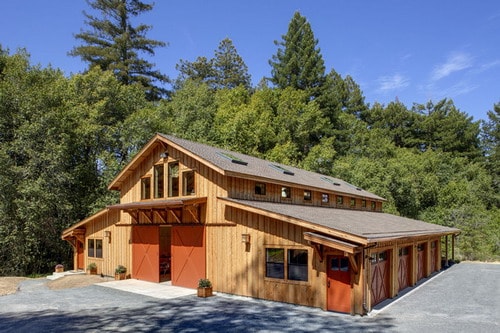Most buildings should be insulated, and pole style buildings are no exception. Insulation in this type of building is usually even more important when it isn’t heated. Pole buildings are typically used for shops, barns or garages. They are strong and can stand up to severe weather, but they usually are not insulated unless the builder is specifically instructed to do so.

Pole Style Buildings
Pole building construction relies on large 6-inch diameter poles that are sunk into the ground on the corners and at regular intervals. Concrete is then poured for the floor to surround and stabilize the poles. The framework is similar to normal framed buildings, except that 2-by-6 lumber is used running horizontally from pole to pole, instead of vertically, as on normal framed buildings. This provides large pockets between the poles and the lumber, perfect for insulation. pole style buildings usually have a metal roof and sides, and metal has little to no insulating properties. This is the primary reason why blanket insulation is needed for pole style buildings.
Blanket Insulation
Start by measuring between the horizontal studs and purchasing the appropriate blanket insulation. You will likely need 24-inch wide insulation that fits a pocket 6 inches deep. It comes in rolls. Measure and use a utility knife to cut the blanket insulation a few inches longer than you need it for each pocket between the poles. If there’s a stud or brace in the middle between the poles, just measure individual pockets or braces. Stuff the insulation into the pocket lightly, with the paper side out, and don’t compress it. There’s a small flap of stiff paper on each long edge of the blanket insulation. Fold the flaps out to overlap the stud on each side. Use a staple gun with a broad staple to fasten the paper lip to the studs, shooting the staples 6 inches apart. The staple should have at least a 1/2-inch leg with at least a 1/2-inch crown. Do every pocket the same way, including the ceiling pockets.
Nylon Wrap
Proper pole insulation requires nylon sheeting over it. This type of material is typically bright white. It resembles canvas, but it has tough threads woven through it to give it strength. Starting from one side, unroll the 48-inch wide roll and begin stapling it at the top and bottom to the horizontal studs using the same staple gun and spacing you used for the insulation. Work your way around the perimeter of the building’s interior, covering the blanket insulation, keeping the roll intact as much as possible without cutting it. It should cover two pockets at a time. When you get to the next level up, you will need to measure and cut it from the roll. Overlap the next piece of wrap over the previous piece on the stud and staple it. Work your way around the pole style buildings, including the ceiling, stapling sections of wrap over the insulation to cover it. There’s no wrong way to do it as long as the insulation is completely covered.
Drywall
It’s not absolutely necessary to drywall over blanket insulation, but it helps tremendously, and keeps the nylon wrap from becoming damaged or torn. Start by placing 1/2-inch blocks on the concrete floor. Stand the drywall up horizontally along the wall on top of the blocks. Use screws to fasten the drywall to the horizontal studs. Lots of pole style buildings are not completely flush on the inside, so the drywall may not be perfect, and corners and edges may be slightly off. If so, just cut the pieces of drywall to fit using a utility knife and screw them to the wall as needed. You don’t need to do the ceiling. Most pole buildings have open rafters, and attempting to drywall on the vaulted part of the ceiling is just too difficult. Other options instead of drywall can be waferboard, plywood, or any other composite material that you want to use to cover the nylon wrap.